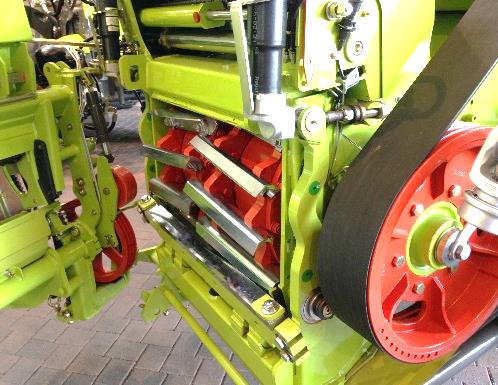“EMIL” Real‐Time Detection of the Blade Sharpness of Agricultural Machines
Problem
Self‐driven forage harvesters are used for harvesting different biomass. The primarily harvested products, such as maize, triticale and grass, are intended for diverse processing purposes, such as e.g. the production of silage. The quality of the silage depends on the degree of sharpness of the used blades of the cutting device of the forage harvester, among others. To optimise the process chain, it is possible to assess the blade condition by the use of Artificial Neural Networks. This provides the operator of the forage harvester with the option to estimate the condition of the blade during the harvesting process. This, in turn, allows for the targeted initialisation of a blade sharpening process. The thus achieved optimisation of the resources and supplies used can contribute to extending the scheduled maintenance intervals while reducing the successive costs for the farmer.
Solution approach
The piezo electrical vibration sensors integrated into the forage harvester not only permit setting the position of the blade drum in respect of the counter‐ blade, but also facilitate the use of this data for assessing the vibration pattern during the harvest. The difference in vibration between sharp and blunt blades is to be used as indicator of the blade condition. Additional blade impressions are produced during the harvesting process to provide a qualitative statement on the blade condition. These impressions are subsequently digitised and analysed in the laboratory by 3D acquisition.
Result
Using computer‐enhanced image evaluation and statistical analyses of the acoustic signals, it is possible to use algorithms for calculating the blade condition. These calculations serve for determining the correct time of sharpening and permit an improved utilisation of the resources used. The use of the integrated vibration pick‐ups has proved to be useful correlation signals for determining the wear of the blades. Differences in the vibration signals with regard to the used harvested product could be determined. Using a developed impression process, it was possible to measure the chopper blades used.
Project partners
Schmalkalden University of Applied Sciences
Faculty of Electrical Engineering
Blechhammer 9 D‐98574 Schmalkalden
Prof. Dr.‐Ing. Andreas Wenzel
Tel.: +49 (0) 3683 688 5113
a.wenzel@hs‐sm.de
Dr.‐Ing. Christian Walther
Tel.: +49 (0) 3683 688 5214
c.walther@hs‐sm.de
CLAAS Selbstfahrende Erntemaschinen GmbH
CSE Predevelopement
University of Kassel
Department of Agricultural Engineering
University of Göttingen (Georg August University)
Institute of Crop Sciences
Department of Agricultural Engineering
Landwirtschaftliche Rentenbank
Additional information
- Duration: 05/2014 – 05/2017
- The project was financed with special‐ purpose funds of the Federal Government:
- Project volume: € 334,435.00
- Funding reference number: Z20135‐2
- pdf: EMIL - Real‐Time Detection of the Blade Sharpness of Agricultural Machines
- pdf (german): EMIL - Echtzeiterkennung der Messerschärfe bei Landmaschinen


